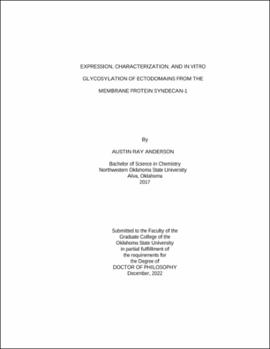| dc.contributor.advisor | Cook, Gabriel A. | |
| dc.contributor.author | Anderson, Austin Ray | |
| dc.date.accessioned | 2023-07-05T20:56:44Z | |
| dc.date.available | 2023-07-05T20:56:44Z | |
| dc.date.issued | 2022-12 | |
| dc.identifier.uri | https://hdl.handle.net/11244/337869 | |
| dc.description.abstract | Membrane proteins are a key component of numerous biological processes such as signal transduction, transportation, and various cell-cell interactions. Nearly one-third of all genes encode for membrane proteins and around one-half of all drug targets are membrane proteins. Despite the significance of these proteins, a relatively small amount of membrane protein structures have been determined. Membrane proteins are difficult to express in high quantities and contain highly hydrophobic domains that generally require solubilization strategies using detergents or lipids. Post-translational modifications further diversify these proteins. Many membrane proteins are glycoproteins with one or more sugar attachment sites. Glycosylation, like other types of post-translational protein modifications, can have a profound effect on the structure and function of these proteins. Syndecan-1 (SDC-1), an integral membrane glycoprotein, is involved in the body’s innate immune response system. When cells are under stress due to infection or trauma, the ectodomains of SDC-1 are cleaved and released into the bloodstream as a way to induce formation of a chemokine gradient that subsequently recruits leukocytes to the affected area. This protein is normally highly glycosylated in nature with one N-linked glycosylation site and five O-linked glycosylation sites. While many important biological functions of SDC-1 have been identified, its structure and specific interactions have not been elucidated. The research efforts in this study have developed a method to reliably express and isolate the recombinant core ectodomain of human syndecan-1 from E. coli cells. We have also laid the foundation for future studies on the structure and dynamics of these ectodomains using 2D and 3D NMR spectroscopy. Using novel methods of in vitro glycosylation, we were successful in attaching a glycan to the syndecan-1 core protein. Solution NMR spectroscopy requires highly homogenous sample conditions that are impossible to attain from glycoproteins that have been isolated from mammalian cells. This work with in vitro glycosylation will provide the highly homogenous sample conditions required to study specific effects of glycosylation on proteins with intact glycans attached to the core protein. | |
| dc.format | application/pdf | |
| dc.language | en_US | |
| dc.rights | Copyright is held by the author who has granted the Oklahoma State University Library the non-exclusive right to share this material in its institutional repository. Contact Digital Library Services at lib-dls@okstate.edu or 405-744-9161 for the permission policy on the use, reproduction or distribution of this material. | |
| dc.title | Expression, characterization, and in vitro glycosylation of ectodomains from the membrane protein syndecan-1 | |
| dc.contributor.committeeMember | Lavine, Barry K. | |
| dc.contributor.committeeMember | Krishnan, Sadagopan | |
| dc.contributor.committeeMember | El Rassi, Ziad | |
| dc.contributor.committeeMember | Zhou, Donghua | |
| osu.filename | Anderson_okstate_0664D_17948.pdf | |
| osu.accesstype | Open Access | |
| dc.type.genre | Dissertation | |
| dc.type.material | Text | |
| dc.subject.keywords | glycosylation | |
| dc.subject.keywords | mass spectrometry | |
| dc.subject.keywords | NMR spectroscopy | |
| dc.subject.keywords | post-translational modifications | |
| dc.subject.keywords | sydecan-1 | |
| thesis.degree.discipline | Chemistry | |
| thesis.degree.grantor | Oklahoma State University | |
